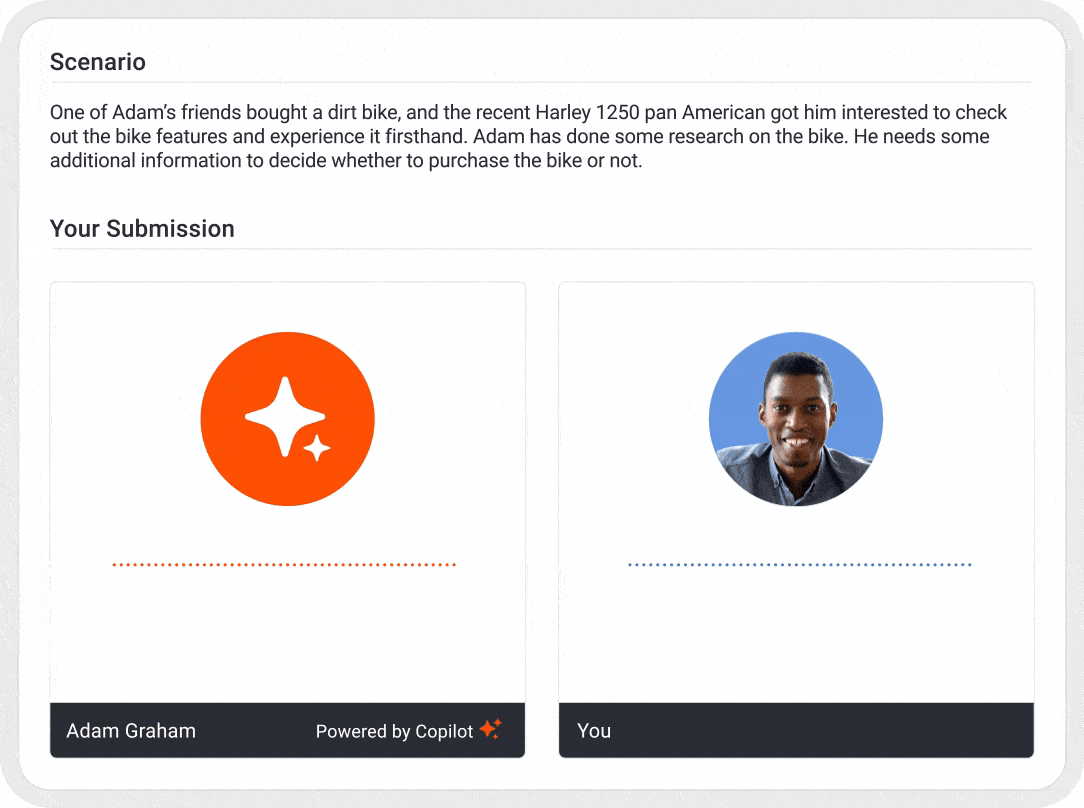In a perfect world, every one of your sales interactions would go without a hitch. Your prospects would always be eager to move to the next stage of the sales process, and you’d never run into any sales objections.
But that’s not reality.
B2B buyers are more informed than ever. And often, they come into sales conversations with plenty of questions and sales objections in tow.
Sellers must become experts at overcoming sales objections to close more deals. The first step is to anticipate sales objections – and know which ones to expect.
In this post, we’ll explore:
- What sales objections are
- Why they matter
- The different types of sales call objections
- Examples of sales objections you’ll likely encounter in the field (and how to address them)
- How AI-powered role-plays can ensure every seller knows how to overcome objections in sales
What is a sales objection and why is it important?
Later, we’ll examine the types and provide examples of each. But first, let’s lay the foundation by defining the phrase and exploring its role in the sales process.
Sales objections, defined
They are the reasons your prospect is hesitant to purchase your product. In other words, they’re the reasons a customer says “no” to taking the next step in the journey or making a purchase.
Of course, there may be any number of reasons why a prospect may have reservations about moving forward. Later on, we’ll take a closer look at some types of sales objections sellers are likely to encounter.
Why overcoming sales objections is critical
They’re inevitable. There’s no getting around that. Research tells us that 60% of customers say “no” four times before finally saying yes.
Customers say "no"
Sure, encountering B2B sales objections can feel discouraging. But those “nos” don’t necessarily mean a deal is dead in the water.
If a sales rep has the right skills, they can effectively overcome sales objections and, ultimately, guide the prospect across the finish line. The best sales reps see them as an opportunity.
Many sellers throw in the towel when they encounter sales objections. According to statistics, a mere 44% of sales reps follow up after receiving a single “no” from a prospect. When a sales rep is persistent, they stand out from the competition – and it can pay off.
When a prospect raises objections, sales reps can ask the right questions to better understand their needs and motives. Then, sellers can use that intel to tailor how they present your solution’s value. Furthermore, while working to overcome them, sellers can build trust with the buyer, increasing their likelihood of purchasing.
It’s no wonder why 95% of companies say objection handling is a key competency for their customer-facing roles.
What are the types of sales objections?
There are endless reasons why a prospect isn’t ready to move forward in the purchase journey. But generally, they fall into one of a few different categories.
Let’s take a closer look at six of the most common types of sales objections.
Sales objection category #1: Pricing
Pricing is one of the biggest objections in sales. A prospect may say that your product is too expensive or they lack the budget.
It’s important to dig deeper into pricing-related sales call objections. Sometimes, a prospect truly can’t afford your product or service. In that case, they may not be a good fit.
However, these pricing objections often arise when a prospect struggles to see the value in your solution. This is an opportunity to reiterate the value the buyer will realize from your product. They’ll be more likely to purchase when they understand what they’ll get from the investment (for example, cost or time savings).
Sales objection category #2: Need
Prospects often raise sales objections because they don’t think they need the solution you’re offering. You might hear something like, “We don’t need that,” or “We’re already doing XYZ to address that.”
Overcoming these objections requires strong sales discovery skills. Sellers need to ask the right questions to understand the prospect’s challenges and determine if they have a solution to address them. If the prospect is a good fit, the seller must articulate why their solution fits the prospect’s needs.
Sales objection category #3: Timing
Prospects often raise sales objections related to timing. For example, they may say, “I’ll think about it” or “This isn’t a priority right now.”
Reps can overcome these B2B sales objections by digging deeper into the prospect’s priorities. There may be an opportunity to provide a solution to their more pressing priorities.
Timing-related sales objections also present an opportunity to create a sense of urgency. Sales reps can help prospects understand the cost of not moving forward, which may cause them to rethink their priorities and take action now.
At the very least, you can suggest scheduling a meeting in the future when they feel ready to move forward.
Sales objection category #4: Decision-making power
In some situations, a prospect will tell you they don’t have the power to decide on your solution. You may hear things like, “I’ll have to talk to my boss” or “I don’t make these kinds of decisions.”
You can use this as an opportunity to identify and contact the person who does have purchasing authority. However, continue building your relationship with the initial contact. If you earn their trust, they may end up championing your solution.
Sales objection category #5: Competition
A recent report found that 57% of all deals are competitive. So sellers should anticipate sales objections related to competitors and be prepared to overcome them.
For example, a prospect may ask why your solution lacks certain features and benefits, or why it’s priced higher than your competitors. Sales reps must become experts in their competitors’ offerings and how they stack up. It’s key to overcoming competitive sales objections.
Sales objection category #6: Lack of trust
Sometimes, sellers will encounter sales objections that indicate a lack of trust. For example, a prospect may say, “I’ve never heard of your company,” or “I don’t know anyone who uses your product.”
While the prospect may not say, “I don’t trust your company,” that’s the underlying meaning.
Sellers must work to build rapport and trust with prospects. This is important in every deal, but especially in those deals where prospects raise trust-related sales objections.
12 examples of sales objections (and how to respond)
Sales objections are extremely common. So sales reps should anticipate them and know how to overcome objections in sales.
A great starting point is to see some examples of sales objections and how to respond to them to maintain a healthy pipeline and close more deals.
Sales objection #1: “Your product is too expensive.”
How to respond: Empathize with the prospect by saying, “I understand you’re working within a budget. Then, remind the prospect how your solution solves their top challenges. By articulating value, you can convince your prospect that this investment is worth making.
Sales objection #2: “Your competitor is cheaper.”
How to respond: Acknowledge that your prospect is correct. Then, work to articulate how your product delivers more value than your competitors – thus worth the investment. Be sure to articulate that your solution is the better choice, but avoid criticizing the competition.
Sales objection #3: “We don’t have any more budget this year.”
How to respond: Say something like, “I understand. When do you expect funding to return? Let’s schedule a follow up meeting for then!”
Sales objection #4: “We’re already using your competitor.”
How to respond: Ask questions like, “What made you choose [company]?” and “How is [company’s solution] working out for you?”
This will help you understand what they like and dislike about your competitor. Then, you can use that information to communicate why your solution is better for addressing their key challenges.
Sales objection #5: “I’ve never heard of your company before.”
How to respond: Say something like, “I’m excited to introduce our company to you!” Then, provide a short and sweet overview of what your company does. You can also say, “Let’s chat more about your challenges and how we might be able to help.”
Offering to share testimonials and reviews from notable customers is also a great way to build trust.
Sales objection #6: “I don’t want to be locked into a year-long contract.”
How to respond: Empathize with them by saying, “I completely get it.” If there are other payment options, let the prospect know. Say something like, “We also offer some other payment terms. Let’s walk through them to see what would work better for you.”
Sales objection #7: “I’m already in a contract with your competitor.”
How to respond: Addressing this objection can be a great way to get insight into what a prospect likes and dislikes about the prospect and whether they’re willing to switch vendors. This information can help you tailor your approach.
In addition, consider offering a discount to offset the cost of switching. You can also convey how switching to your solution can deliver ROI that makes up for the cost of switching.
Sales objection #8: “I don’t have the authority to sign off on this.”
How to respond: Ask questions to get in touch with the right question. You can say something like, “Thanks for letting me know! Can you let me know who is authorized to make this decision and how I can get in contact with them?”
Keep in touch with your original point of contact. They may be able to make introductions and even serve as a champion for your company.
Sales objection #9: “This isn’t a priority right now.”
How to respond: Say something like, “Got it! What are your current priorities right now?”
If they’re unable to articulate those priorities, they’re likely just using it as an excuse to brush you off. This is an opportunity to articulate value and create a sense of urgency.
If they do share their current priorities, see if there are ways your solution can help. If not, set a follow-up meeting for when this is a priority. While you wait for the meeting, share helpful resources to keep the prospect engaged and earn their trust.
Sales objection #10: “Your product is too complicated.”
How to respond: Ask your prospect what features seem complicated. Then, work to provide clarity.
In addition, remind the prospect that they’ll have ongoing support to ensure they get the most value from your solution. You can say something like, “You’ll have a dedicated customer success manager who is an expert at helping businesses like yours solve [pain points] with our solution.”
Sales objection #11: “We don’t have the capacity to bring on a new product right now.”
How to respond: First, ensure your prospect has a clear idea of what it takes to implement your product and drive adoption. It may not be as complicated as they think.
In addition, ask questions like, “Can you tell me more about your day-to-day responsibilities?” Then, you can articulate how your solution will help streamline their day-to-day tasks so they can spend more time on strategic initiatives.
Sales objection #12: “I’m busy.”
How to respond: Let your prospect know you’re not looking to take up much of their time. You just want to have a quick chat to determine if it makes sense to have a longer discussion.
Say something like, “I hear you. I promise this won’t take up too much of your time. Can we have a five-minute chat now about [this challenge] and how I might be able to help?”
If they still say no, suggest scheduling a quick call for a better time.
How Mindtickle empowers sellers to overcome sales objections and close more deals
Sales call objections are inevitable. Every seller must master the art of overcoming B2B sales objections.
Delivering sales training and coaching focused on overcoming objections in sales is a great first step. Giving your sales reps plenty of opportunities to practice and perfect their skills is important before money is on the line.
Mindtickle now features AI-powered role-plays that enable sellers to practice their objection-handling skills as much as they’d like in a safe, scalable environment.
With Mindtickle, sales enablement teams can create realistic role-play scenarios and set the title of a realistic, artificial intelligence-powered bot. Enablement teams can even select levers to set the buyer’s personality – such as “budget conscious” or “extroverted.”

Sales reps launch the role-play and have the opportunity to practice their key skills – including overcoming sales objections – in a dynamic, realistic scenario. The bot raises objections throughout the role-play, which the sales rep must work to overcome.
Throughout the role-play experience, AI delivers qualitative and quantitative feedback and suggestions for improvement around key factors, including objection handling. Sales reps can use this feedback to give it another go until they feel confident in their sales objection handling skills. Then, they can make real-life sales calls, confident in their ability to overcome different types of sales objections.
Practice objection handling
Pitch to Mindtickle Copilot in realistic selling scenarios to see if you can handle objections and seal the deal.
Practice with Copilot



 By Helen Waite
By Helen Waite

 By Rahul Mathew
By Rahul Mathew